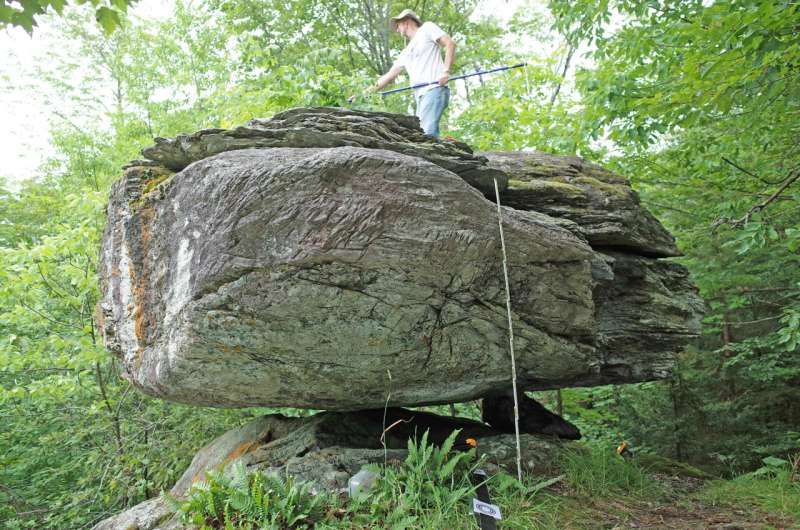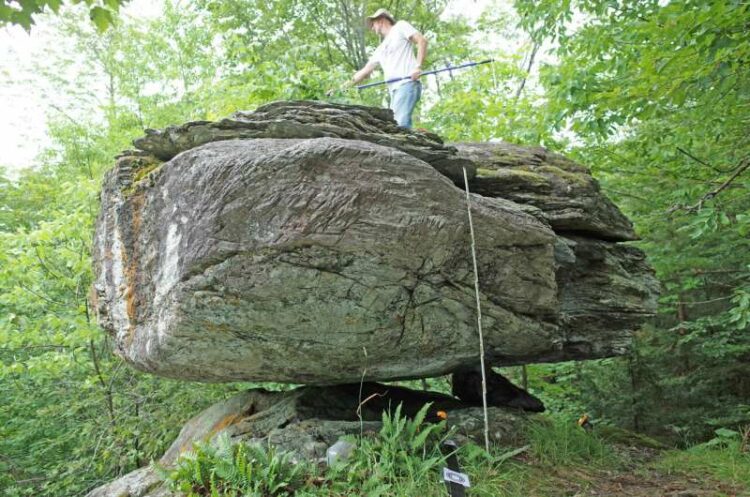
A precariously balanced rock at Westfield, Vermont. USGS seismologist Thomas Pratt stands on top. The 2-meter measuring stick is provided for scale. Credit: Devin McPhillips
Five boulders, delivered by glacier and balancing delicately on rocky pedestals in northern New York and Vermont, can help define long-term maximum shaking intensity of earthquakes in the region.
Seismologists examine the fragility of precariously balanced rocks, or PBRs, to determine the intensity of shaking that would be needed to dislodge them from their perch. The age of the rock formations provides information on how long it’s been since a particular region experienced that level of shaking.
According to a report in the Bulletin of the Seismological Society of America, data from the set of five New York and Vermont PBRs are generally consistent with the average level of earthquake ground shaking for the region predicted by the U.S. Geological Survey’s 2023 National Seismic Hazard Model.
Only one PBR, measured at Blue Ridge Road in New York, suggested a possible reduction in median hazard for the nearby region. The continued “survival” of this PBR may exclude magnitude 7.0 earthquake sources from large parts of the Adirondack Mountains and the southern Lake Champlain valley, according to Devin McPhillips and Thomas Pratt of the U.S. Geological Survey.
However, the overall PBR data would allow for an earthquake of magnitude 6.5 to 7.0 in the northern Adirondacks or Lake Champlain valley, the authors note.
The researchers also created a map that shows the minimum distance at which a plausible large earthquake source could be located and still not topple a particular PBR. Maps like this can help define the location of active faults in the region.
Seismologists have used other geological features that record shaking, such as liquefaction in the New Madrid and central Virginia seismic zones, to help define seismic hazard in the eastern U.S., said Pratt. But much of the previous work using PBRs to define earthquake hazards comes from places like New Zealand and Australia and the western United States.
“I think the main reason is that this field is just beginning to mature. The limited work so far has focused on the places with the greatest hazard and risk,” McPhillips explained. “Another likely reason is the early focus on precariously balanced rocks formed by weathering and erosion of bedrock core stones. That process doesn’t form many precarious rocks in the northeast, but it turns out that other processes do.”
All the PBRs studied by McPhillips and Pratt are glacial erratics—boulders picked up and left behind by glaciers. The boulders balance on rock pedestals scoured and grooved by glacier movement. The last ice sheets retreated from the region between 15,000 and 13,000 years ago, indicating the PBRs are around that age.
The rugged, heavily forested landscape made it difficult to identify fragile PBRs in the region, “so we needed local knowledge,” said McPhillips.
“The project really got going when Tom found these hobbyist books documenting interesting rocks. [New York hiking guide] Russell Dunn was especially helpful in New York and Jan and Christy Butler in Vermont have created an excellent guide there. Climbers also had some useful information on forums like Mountain Project.”
The researchers quantified the fragility of five PBRs after surveying them with ground-based lidar, field observations and seismic response. After defining the boulders, pedestals and contact points between the two, McPhillips and Pratt were able to calculate the probability of the boulder toppling from its perch as a function of peak ground acceleration and the ratio of peak ground velocity to peak ground acceleration.
The results should help better define seismic hazard in this part of the eastern U.S., the researchers said. Northern New York and northwestern Vermont have elevated seismic hazard compared to most other parts of the eastern U.S, due to high rates of historical seismicity.
This history includes the 1944 magnitude 5.7 Massena, the 1983 5.1 Newcomb and the 2002 magnitude 5.3 Au Sable earthquakes in New York. Nearby, the Western Quebec Seismic Zone and the Charlevoix Seismic Zone hosted a magnitude 7.3 to 7.9 earthquake in 1663.
McPhillips was happy to see that their data were consistent with the USGS’ seismic hazard model, especially as “we were able to calculate shaking intensity constraints over time intervals several orders of magnitude longer than any previously available data.”
“I’m looking forward to finding more PBRs—we can likely do better than the five that we start with in this paper,” he added.
More information:
Devin McPhillips et al, Precariously Balanced Rocks in Northern New York and Vermont, U.S.A.: Ground-Motion Constraints and Implications for Fault Sources, Bulletin of the Seismological Society of America (2024). DOI: 10.1785/0120240069
Provided by
Seismological Society of America
Citation:
Precariously balanced rocks in New York, Vermont provide limits on earthquake shaking (2024, September 11)
retrieved 11 September 2024
from
This document is subject to copyright. Apart from any fair dealing for the purpose of private study or research, no
part may be reproduced without the written permission. The content is provided for information purposes only.
Source link : http://www.bing.com/news/apiclick.aspx?ref=FexRss&aid=&tid=66e1d20a6c3e473b97e9ab26c96e8e83&url=https%3A%2F%2Fphys.org%2Fnews%2F2024-09-precariously-york-vermont-limits-earthquake.html&c=10161425274522631978&mkt=en-us
Author :
Publish date : 2024-09-10 13:00:00
Copyright for syndicated content belongs to the linked Source.
